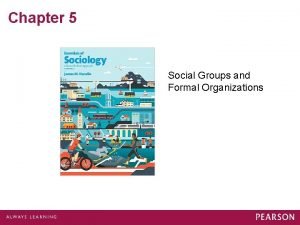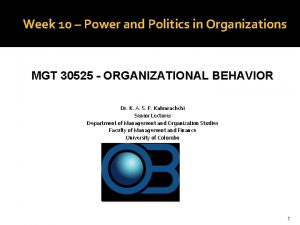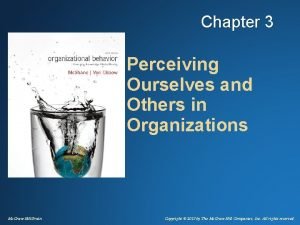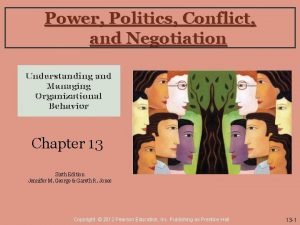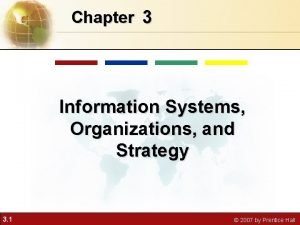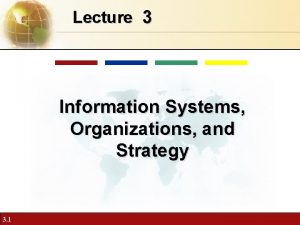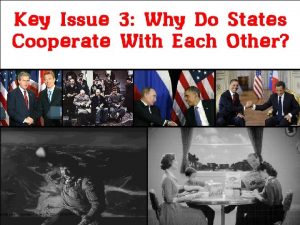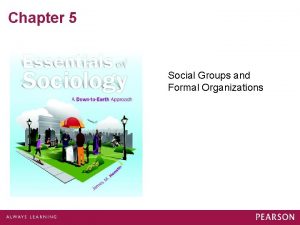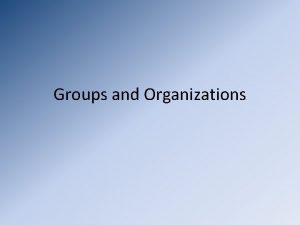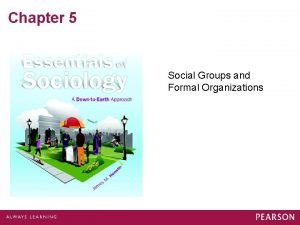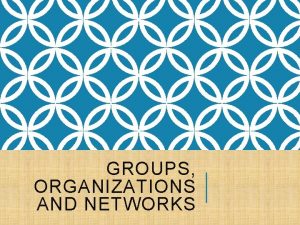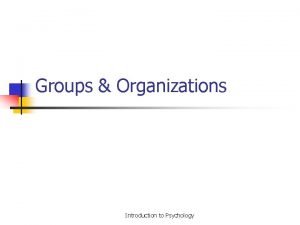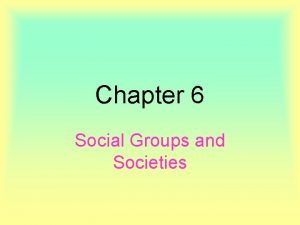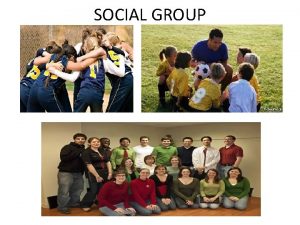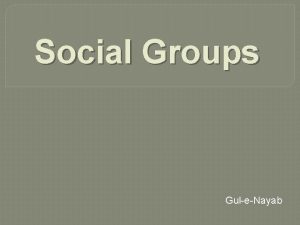5 Social Groups and Organizations Social Groups A















- Slides: 15

5. Social Groups and Organizations

Social Groups • A social group a collection of people who interact with each other and share similar characteristics and a sense of unity. • A social category is a collection of people who do not interact but who share similar characteristics. • Social aggregate is a collection of people who are in the same place, but who do not interact or share characteristics

Types of group Primary groups are characterized by intimate face-toface association and those are fundamental in the development and continued adjustment of their members. Secondary groups are those in which individuals do not interact much. They are characterized by: • Dominance of secondary relations • Largeness of the size, • Membership, • No physical basis, • Nature of group control, • Group structure • Limited influence on personality.

Small groups The smallest of small groups is a dyad consisting of two people. A dyad is perhaps the most cohesive of all groups because of its potential for very close and intense interactions. It also runs the risk, though, of splitting up. A triad is a group consisting of three persons. A triad does not tend to be as cohesive and personal as a dyad.

• Social Organization Social organization is used to stress the importance of arrangement of parts in which the parts of society are related to each other and how each is related to the whole society. • The relationship between the Formal and Informal Organization The most efficient and satisfactory organization is the one in which formal organization is supported the informal organization.

• The differences between formal and informal organization 1. The formal organization consists of the formally recognized and established statuses of the members. The relationship between the members is more a status relationship than a personal relationship. The informal organization consists of role rather than statuses. The relationship between the members is more a personal relationship or role relationship than the status relationship.

2. There is authority in formal organizations hence there is super ordination and subordination. Individuals are valuable because of their status and prestige. There is leadership in informal organization; hence we find dominance and submission. Individuals are valuable because of their roles and esteem. 3. The norms of formal organization differ. They are found in the form of written rules, regulations, laws contracts or constitutions. They are also informal. They may be found in the form of customs, morals, folkways, belief and they are not written.

4. Formal organizations may have long history of their own. The state or clubs are relatively permanent and stable. Informal organizations are not very permanent. 5. Formal organizations are comparatively more inflexible. It is not easy to bring change in them for example it is not easy to bring change or amendment in the constitution. Informal organizations are more flexible. There is no rigidity here. Changes can be brought forth easily. It requires only the change in attitudes of the members.

Role of Individual in organizations • The individuals play an important role in the functioning of the organization. • People tend to identify themselves with the organization in which they participate. • The individual motives play an important role in the fulfillment of organization goals. • The success of an organization depends not only on the proper coordination and cooperation of its members but also on the cooperation of others.

• The success of an organization depends not only on the proper coordination and cooperation of its members but also on the cooperation of others. • An organization is said to have attained equilibrium when it is able to maintain the continued contribution of all its participants

Colleges, businesses, political parties, the military, universities, and hospitals are all examples of formal organizations. The informal relations among workers comprise informal organizations

Bureaucratic organizations Max Weber believed that bureaucracy is the most efficient form of organization possible, According to Weber, the essential characteristics of a bureaucracy include • Written regulations and rules, which maximize bureaucratic operations and efficiency. • A highly defined hierarchy of authority, in which those higher in the hierarchy give orders to those lower in the hierarchy. Those who work in bureaucratic settings are called bureaucrats. • Bureaucratic authority resting in various offices or positions, not in individuals. • Employees being hired based on technical know-how and performance on entry examinations. • Formal and impersonal record keeping and communications within the organization. • A paid administrative staff.

• Within any bureaucracy, informal relationships invariably form, which can increase worker satisfaction, but only to a point. Informal groups can become disruptive to the efficiency of the bureaucracy. • Critics of Weber note that bureaucracy can also promote inefficiency. A bureaucracy can only formulate rules based on what it knows or expects.

Advantages of bureaucracy 1. red tape 2. the impersonality 3. job security Disadvantages of bureaucracy 1. Bureaucratic regulations and rules are not very helpful when unexpected situations arise. 2. Paper trails. 3. governmental red tape costs both time and money.

Collectivist organizations • Marx predicted that bureaucracies would eventually disappear in a communist (classless) society, and that collectivist organizations, in which supervisors and workers function as equals for equal wages, would replace the bureaucracies. • A variation of the collective organizational model has been tried in China, but with limited success. • Critics note that collectivist organizations do not work because “leader” and “followers” inevitably emerge when groups of people are involved
 Social groups and formal organizations
Social groups and formal organizations Formal groups fulfill both and functions in organizations.
Formal groups fulfill both and functions in organizations. How are ethnic groups and religious groups related
How are ethnic groups and religious groups related Power and politics in organizations
Power and politics in organizations Voluntary health and welfare organization examples
Voluntary health and welfare organization examples Floral shops bookstores and farms are examples of
Floral shops bookstores and farms are examples of Persuasive communication
Persuasive communication Power, politics and conflict in organizations
Power, politics and conflict in organizations Perceiving ourselves and others in organizations
Perceiving ourselves and others in organizations Introduction to management chapter 1
Introduction to management chapter 1 Csusm clubs and organizations
Csusm clubs and organizations Conflict power and politics
Conflict power and politics Physical property of ammonia
Physical property of ammonia Inventing and reinventing organizations
Inventing and reinventing organizations Information systems organizations and strategy
Information systems organizations and strategy Information systems, organizations, and strategy
Information systems, organizations, and strategy
